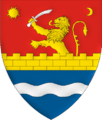Banloc
| Banloc | |
|---|---|
| Commune | |
 Banloc Location of Banloc, Timiș | |
| Coordinates: 45°23′N 21°8′E / 45.383°N 21.133°E | |
| Country |
|
| County |
|
| Founded | 1400 (first official record) |
| Government | |
| • Mayor | Lucian Trifonescu (PNL) |
| Area | 173.60 km2 (67.03 sq mi) |
| Population (2002)[1] | 4,525 |
| Time zone | EET (UTC+2) |
| • Summer (DST) | EEST (UTC+3) |
| Postal Code | 307010 |
| Website | http://www.e-primarii.ro/primaria-banloc/ |
Banloc (German: Banlok; Hungarian: Bánlak) is a commune in Timiș County, Romania. It is composed of four villages: Banloc, Ofsenița (Ofsenitz; Karátsonyifalva), Partoș (Partos) and Soca (Karátsonyiliget).
Name
Banloc name was originally born by the fusion of two words: the name of the god "Pan" and the word "loc" (place), "Pan's place".[2] Later, when the "pan" became "ban", it kept the original meaning of a master. The Panloc castle became the Banloc castle, name preserved until now. There is a relief above one of the access doors in the basement of the castle, bas-relief depicting the god Pan playing the syrinx. Also, statues in the form of fauns used to guard the alleys of the park, fragments of these are currently held at the Museum of Banat in Timișoara, along with several other statues of the same origin.
History

The commune is first attested on May 13, 1400 in a document given to the clerk of Cenad, under the name of „Byallak”. For almost two centuries (1552–1716) it was the summer residence of Temeşvar Eyalet's pasha. In 1716, Banat was conquered by the Austrians. At the census of 1717, it was registered as Panloch, belonging to the Ciacova district with 85 inhabited houses. On Count Mercy's map made between 1723-1725, the village appears as Banlok. Although, the state area of Banloc is assigned, by the exchange of land, to the Croatian Ban of Drašković. In 1783 the domain is sold to Count Lázár Karátsonyi from the Karátsonyi of Beodra (now Novo Miloševo, Serbia, Vojvodina province), which ten years later built on ancient foundations, the current castle located in the center of the village.
The history of Banloc is closely linked to the history of the domain and its economic performance. The domain of the Karátsonyi counts included extensive forests rich with game, farmland - most of which were spectacular rice fields from Topolea (Hungarian: Topolyapuszta)[3] - fishing lakes, tobacco plantations, farm animals (from Pescuș), stud farms, a distillery and a mill located near the train station in Banloc. After 1919, the domain loses a part of the land due to the border that appeared between the Kingdom of Romania and the Kingdom of Yugoslavia. Even after the agricultural reform of 1921, the Banloc area with the castle and park remained one of the largest in the country. The Royal House of Romania becomes interested in its fate and, in 1935, it was redeemed from the Karátsonyi family. Banloc becomes royal domain and permanent residence of Princess Elizabeth - former Queen of Greece - sister of King Carol II of Romania.
Landmarks
- Banloc Castle
- "Sf. Iosif cel Nou" monastery in the Partoș village
Gallery
-
Banloc Castle in 2007
-
Glorieta
-
Gate to the Castle
-

Andrássy alley
References
Coordinates: 45°23′N 21°08′E / 45.383°N 21.133°E
